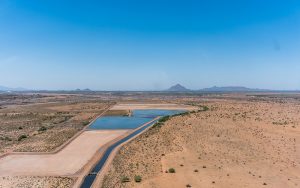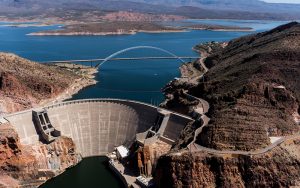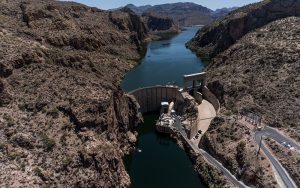By CASEY KUHN
KJZZ
PHOENIX – Valley cities rely mostly on dams and reservoirs for their water needs, but the snowpack feeding those reservoirs was near record low this year. That means managers are looking to future water supplies underground.
Flying in a helicopter over Bartlett Reservoir in Tonto National Forest, Salt River Project surface-water manager Charlie Ester admires the beauty of the glittering blue lake surrounded by the rocky desert forest.
“Bartlett is one of my favorite locations, I just love the terrain around it, it’s just a great reservoir,” Ester said.
Even after 35 years of managing the Salt and Verde rivers for SRP, Ester still is wowed by the water tableau the rivers have carved into the red desert landscape, as well as the dams humans have inserted into the picture.
“The dam’s really well-behaved as well, it always performs well in a flood event,” Ester said, speaking of the infrastructure as if it were a person.
Lately, though, Ester has dealt with more dry years than flood events as the Valley marches into another year of drought. He said this is the 21st year of the drought; other experts say it’s the 18th.
This year saw a near-record low snowpack, which meant near-record low runoff at only about 100,000 acre-feet of water.
Compare that with 1 million acre-feet the year before, which was an outlier in a record six consecutive dry winters.
That stretch of dry winters, Ester said, “is not only the first time in our historical record, but that never showed up in the tree-ring record as well. So in over 800 years, that’s the first time there were six dry years in a row.”
An acre-foot is a measure of how much water would be needed to flood an acre of land to depth of 1 foot. Hardly any acre-feet trickled into Bartlett Lake this year.
“You’ll see that it’s down quite a bit,” Ester said. “Its capacity today is 45 percent.”
Not great, but not worrying, not yet. That’s because SRP augments those low runoff years by pumping groundwater.
Keep flying southwest of Bartlett, along a snaking canal, and you get to Phoenix, which receives 58 percent of its water supply from SRP.
Phoenix hedges bets of worst-scenario water crisis with diverse portfolio
“It is really important that we are prepared for any scenario, including worst-case scenarios,” said Kathryn Sorensen, director of water services for Phoenix. “Because the consequences of failure are just too great.”
After a sweeping measure to manage Arizona groundwater in 1980, cities invested hundreds of millions of dollars for surface-water treatment. That’s helped recharge the aquifer below central Arizona.
SRP and Phoenix, as well as several other Valley cities, have pumped more than a million acre-feet back into the aquifer through the Granite Reef Underground Storage Project, or GRUSP, the largest of more than half a dozen recharge sites in the state. SRP operates a second recharge site in the New River-Agua Fria River area.
“Recharge has been a cornerstone of drought preparation here in the Valley, and it will continue to be in the future,” Sorensen said.
Think of water-supply options as bank accounts. Reservoirs are like checking accounts, with city water available immediately and easily. Underground recharge is like a savings account, where cities take unused surface water and put it in the ground to withdraw later.
This future use will be especially important when surface water, most likely from the Colorado River, is restricted due to persistent drought.
GRUSP: Elegant acronym for simple aquifer recharge system
Groundwater recharge areas are big, brown fields that SRP periodically floods so water seeps through the sand and into the water table hundreds of feet below the surface. Water comes from the Salt and Verde rivers, Central Arizona Project water and reclaimed water from a Mesa reclamation facility.
Some call recharging groundwater the “dams of the future.”
“It’s critical that we still have existing use of our reservoirs,” said Christa McJunkin, water strategy director at SRP, “but you have to have underground storage because it offers unique benefits.”
One benefit is no loss to evaporation. The geology that makes a site good for groundwater recharging rests in its composition. The 197-acre GRUSP is on the ancient bed of the Salt River north of Mesa, where the rocky, sandy soil are perfect for storing water.
Wwater managers predict other recharge sites will be necessary, but where they should be placed isn’t clear.
“As urbanization happens,” McJunkin said, “you don’t want the best place for a recharge project to be a shopping mall.”
That growth and urbanization is one concern cities are dealing with as water demand creeps up and supply holds steady.
The GRUSP is one option, McJunkin said, of finding new ways to get more usable water, such as raw wastewater from Mesa and Peoria, into the system.
“This is one way to bring effluent (wastewater) to use without having to do the additional, high-level treatment you would need to do if you were using it directly,” McJunkin said. “The process of the water infiltrating through the soil takes care of a lot of concerns people have. You can think of it as a huge filter.”
And with water supplies banked for years, water managers in central Arizona are optimistic the taps are in little danger of running dry.
This story is part of Elemental: Covering Sustainability, a new multimedia collaboration between Cronkite News, Arizona PBS, KJZZ, KPCC, Rocky Mountain PBS and PBS SoCal.
Connect with us on Facebook.
For more stories from Cronkite News, visit cronkitenews.azpbs.org.
^_=


